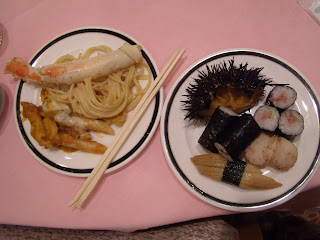


The school visit started with a briefing about education in this area by the Kesennuma City Board of Education.
-Kesennuma is the hub of ESD in Japan
-Population of Kesennuma: 75,000
-21 elementary schools (3803 students, 308 teachers)
-13 junior high schools (2353 students, 227 teachers)
-6 high schools
-3 school-related facilitites
-15 sports facilities
-education accessible to all

Nakai elementary has developed and implemented Global Learning to foster students' global perspectives and communication skills. Three main education policies are:
1. promotion of international education by using ALT's (Assistant Language Teacher) and teaching English starting in elementary school,
2. promotion of ESD, and
3. improving teacher training and quality.

In order to encourage the above, Kesennuma schools have ALT's helping teachers with the English component and elementary teachers have been working with jr-sr high teachers to help teachers adjust to teaching English in the elementary schools. In addition, since 2003, over 1000 students have gone to Australia for 2 week home stays. Teachers can now take professional development courses locally.

Kesennuma City promotes ESD and is a forerunner at all levels, from elementary to university levels (Myagi Univ.). The city has signed a memorandum with the Department of Education to align education of sustainability and has taken the motto, "The Forest is the Sweetheart of the Ocean."
The majority of schools in Kesennuma are UNESCO schools.
NAKAI ELEMENTARY SCHOOLAfter our morning educational policy session, young students came to the school library to lead each one of us individually to the gymnasium. Each American teacher had a kindergarten student leading us by the hand as we descended a stairwell covered with arches layered in brightly colored tissue paper flowers, then through a gauntlet of students waiving American flags. As we entered the gym, we were led to the stage, where chairs were set up for us. It was quite a feeling; many held back tears, while others let them flow freely. All of the schools students were on the gym floor, looking up to us on stage. After brief introductions, we were treated to a few songs by the students. The first song was a bilingual version of "It's a Small World". I have video of the touching performance, but cannot post it on-line. We then were introduced to an interactive game and played several rounds with the students on the gym floor.
(Student faces purposely blurred...)

After the assembly, teachers were assigned specific classrooms where we were to have lunch.
Lunch in this school was an amazing thing to watch. Students put on their white frocks and hats and each proceeded to complete their assigned duties. Some went to the hall to get the meal (prepared in a different building, then shipped to the schools in large thermal containers), while others continued to prepare the classroom for lunch (set up desks, wash desks, ...). Each student also had a small bag at their desks that contained their cloth napkin and chopsticks, another bag that contains their "work" clothes (apron, bandana), and a small seat pad to sit on.

A few students had bento boxes (see June 24) with home meals, but this was in addition to their school meal. Students then served the meal for everyone in the classroom.


Once everyone was seated, the teacher said a quick grace and students replied, then we all ate.

After lunch, the teacher and students gave thanks for the meal they just had and the teacher put on a recorded song so that students could brush their teeth a specific amount of time, until the song was finished. Then, they all got up to go to the hallway sink (long basin with many faucets) to rinse their cups and brushes.

The next task was to change from the white frocks and hats to aprons and bandanas.

Again, each student had an assigned chore: some got out brooms and mops, others got out the dustpans, others moved the desks to one side, others got out rags, and still others, sponges to clean the board. The students then proceeded to clean their classroom, and I helped sweep the floor! This is done everyday after lunch, by the students (all grade levels in this school, K-6). It was awesome seeing the young students go through the motions of lunch and cleaning, without the teacher telling them what to do.
After lunch, American teachers visited the school and observed classes in action.
(empty classes, can't post students...)


One room that I found really neat was a formal Japanese "sitting" room, with tatami mat, where children are taught proper manners, everything from formal tea ceremonies to eating meals. We also saw traditional Japanese toys stored in a book case.
PrincipalNaoto Matsumoto showing us the room:

The afternoon continued with more curriculum information and a presentation by Mr. Yukihiko Oikawa, Vice Principal and author of Mobius for Sustainability, a very interesting publication outlining Kesennuma's efforts for ESD. You can view this publication by clicking on
Mobius for Sustainability.
Today will be difficult to top!
Our departure from Nakai (teachers and students waving goodbye):

 American teachers were invited to try out the taiko. Yours truly is on the left:
American teachers were invited to try out the taiko. Yours truly is on the left:
 Sea urchins are black below:
Sea urchins are black below:



















































